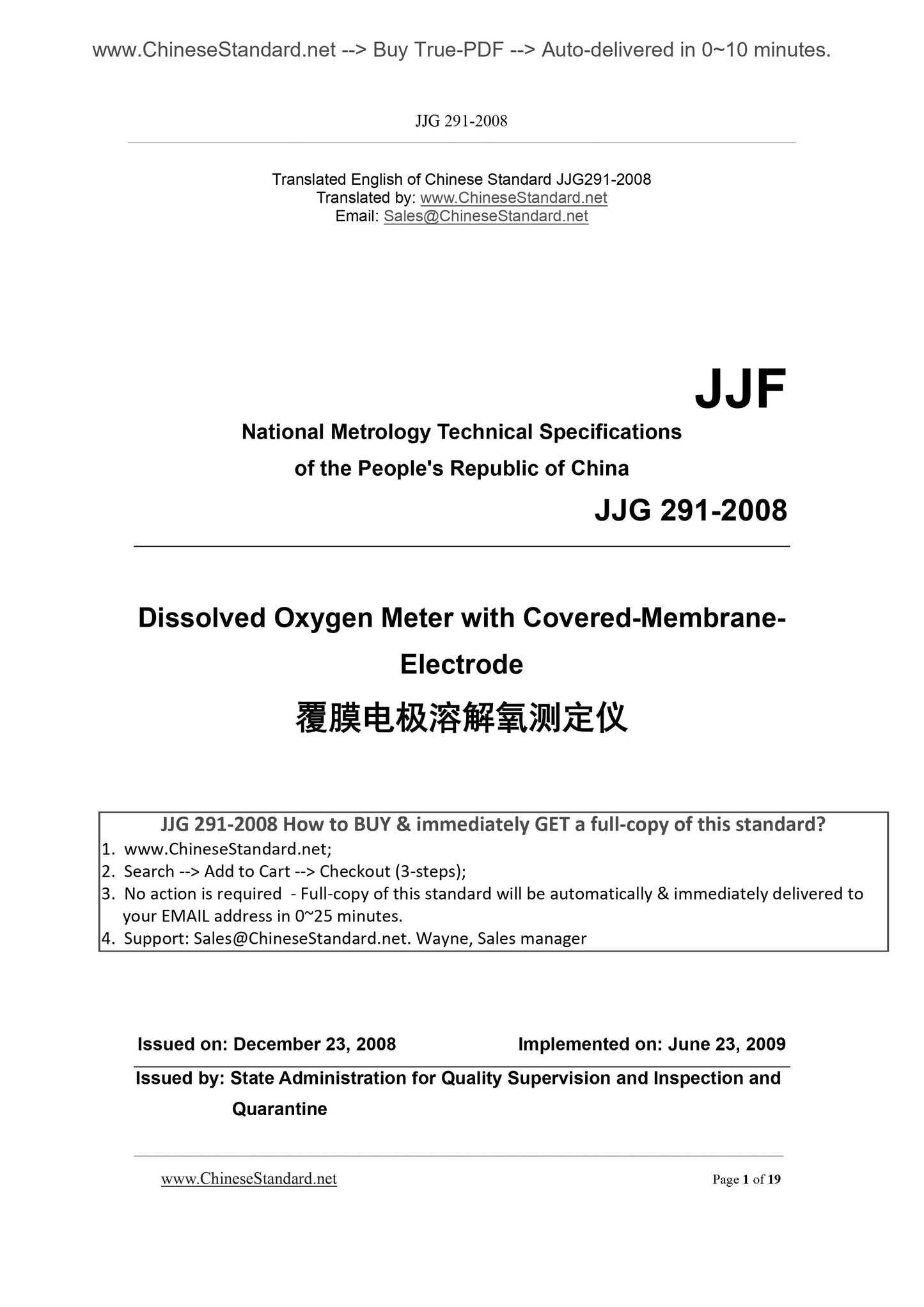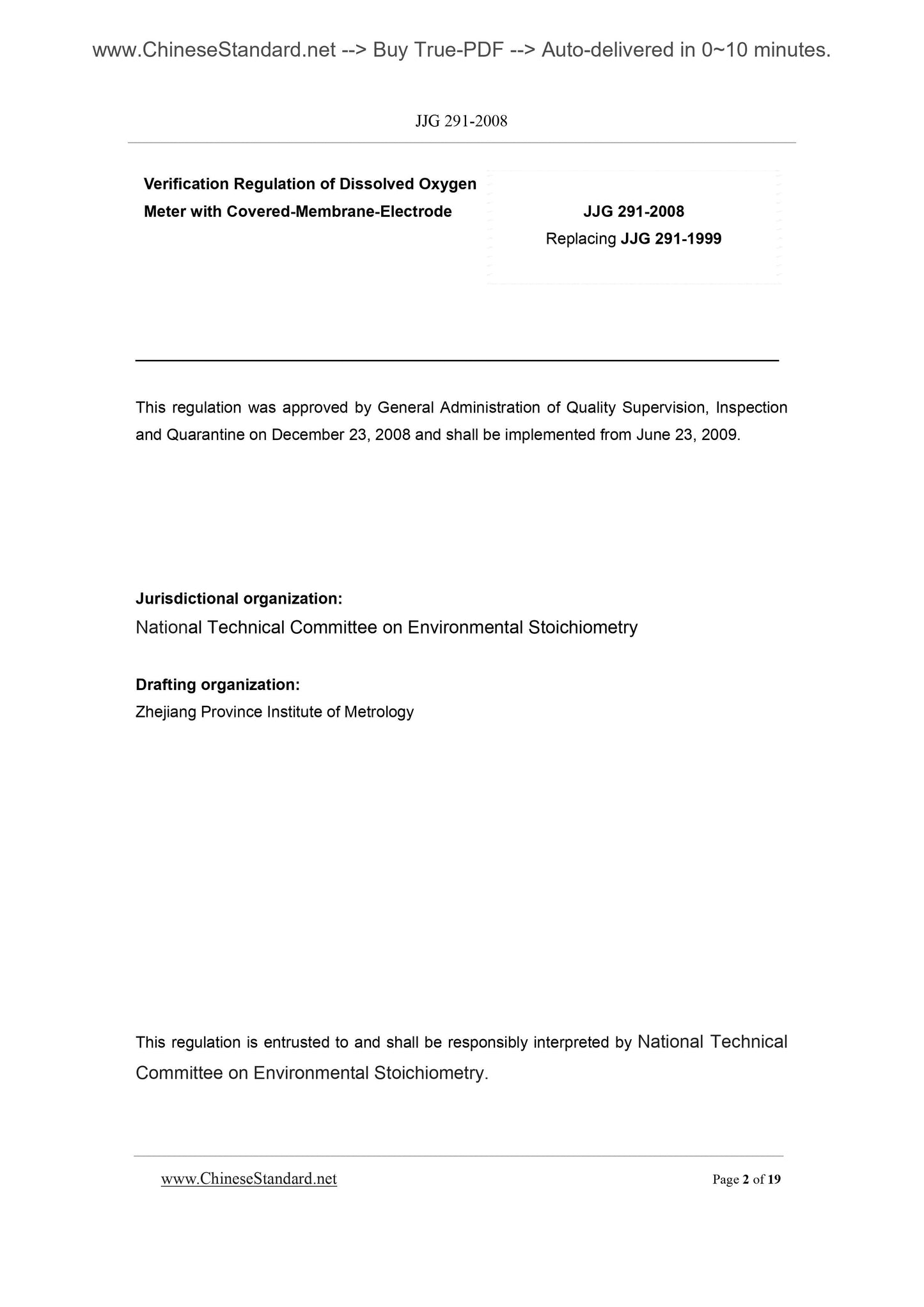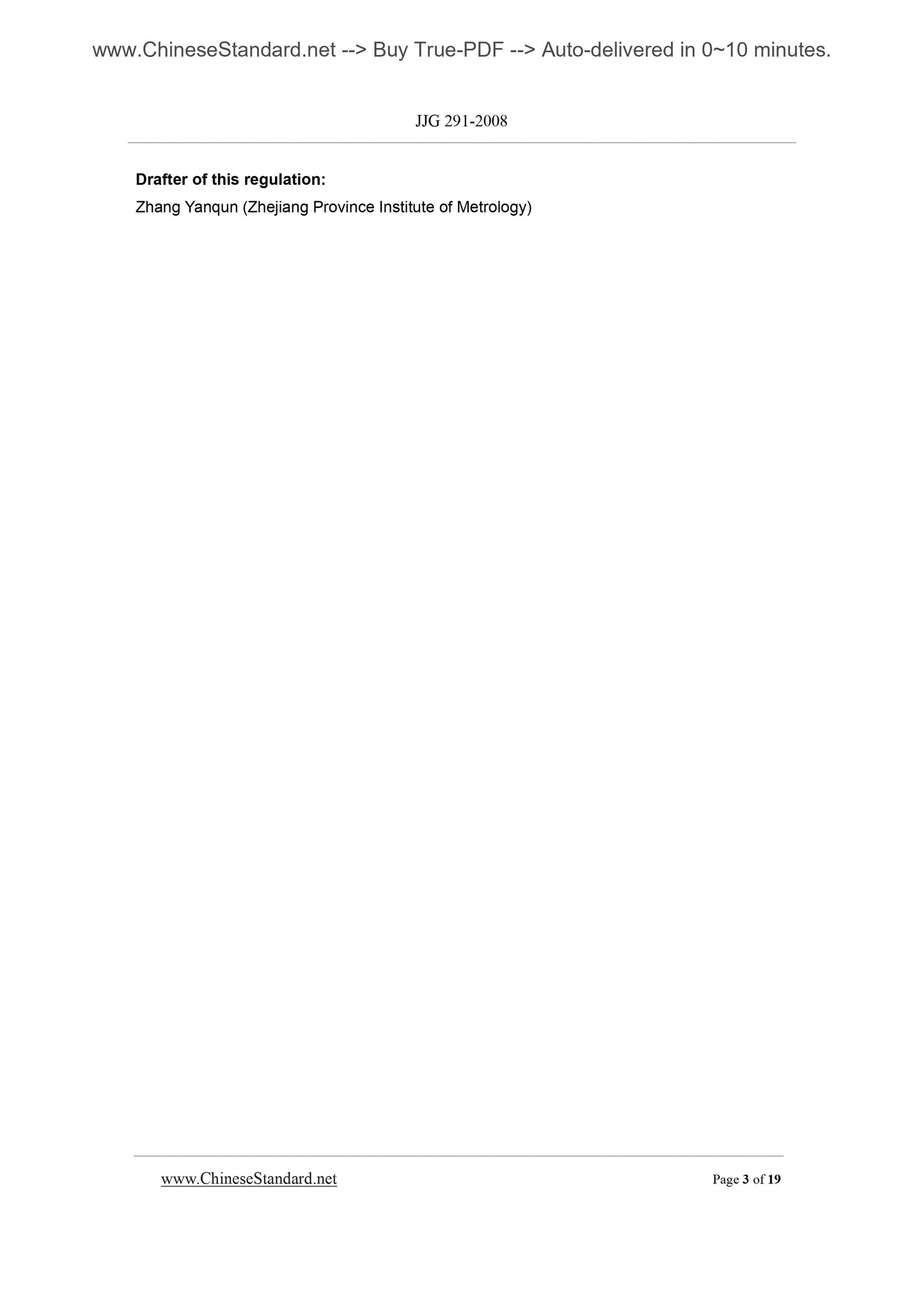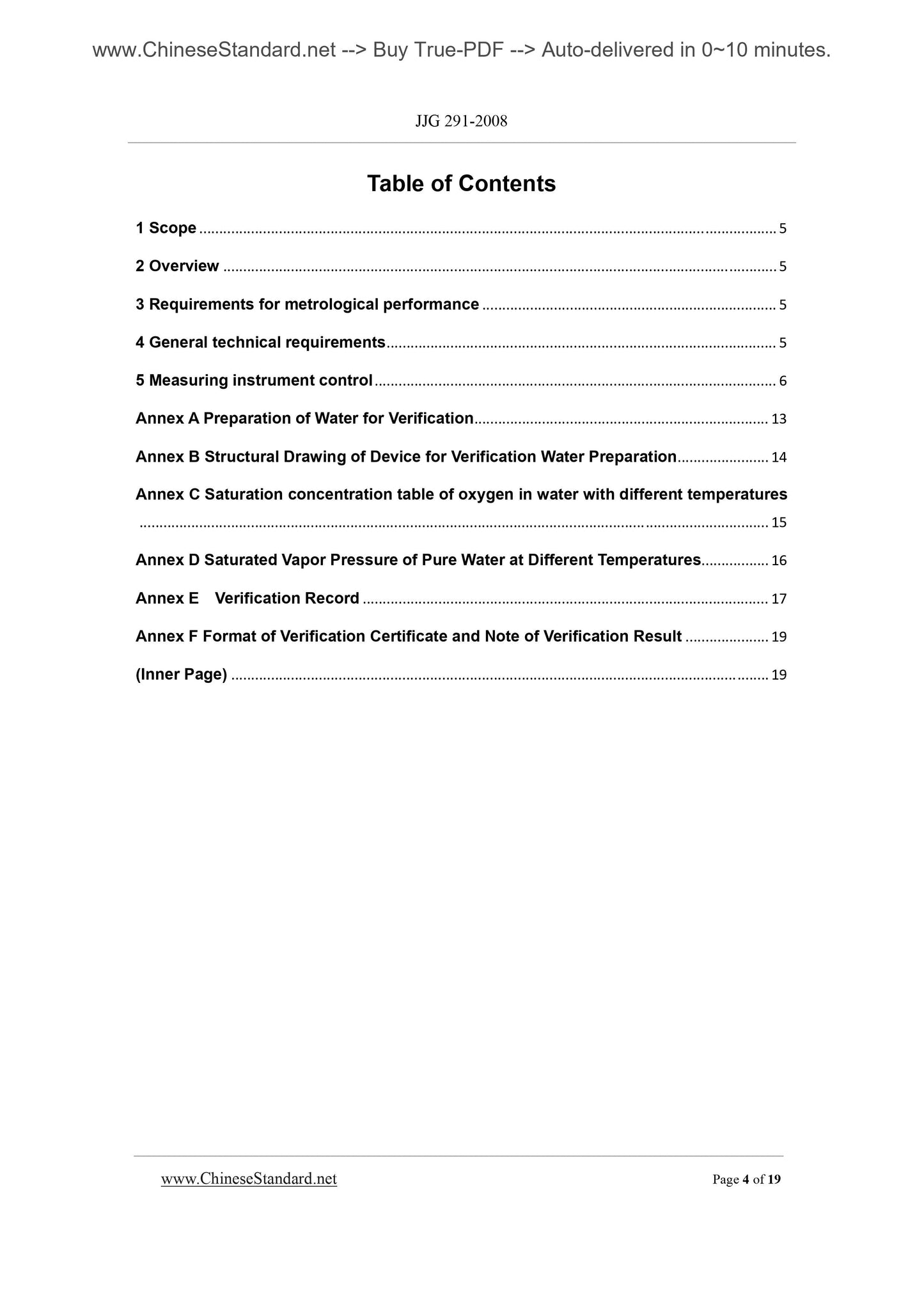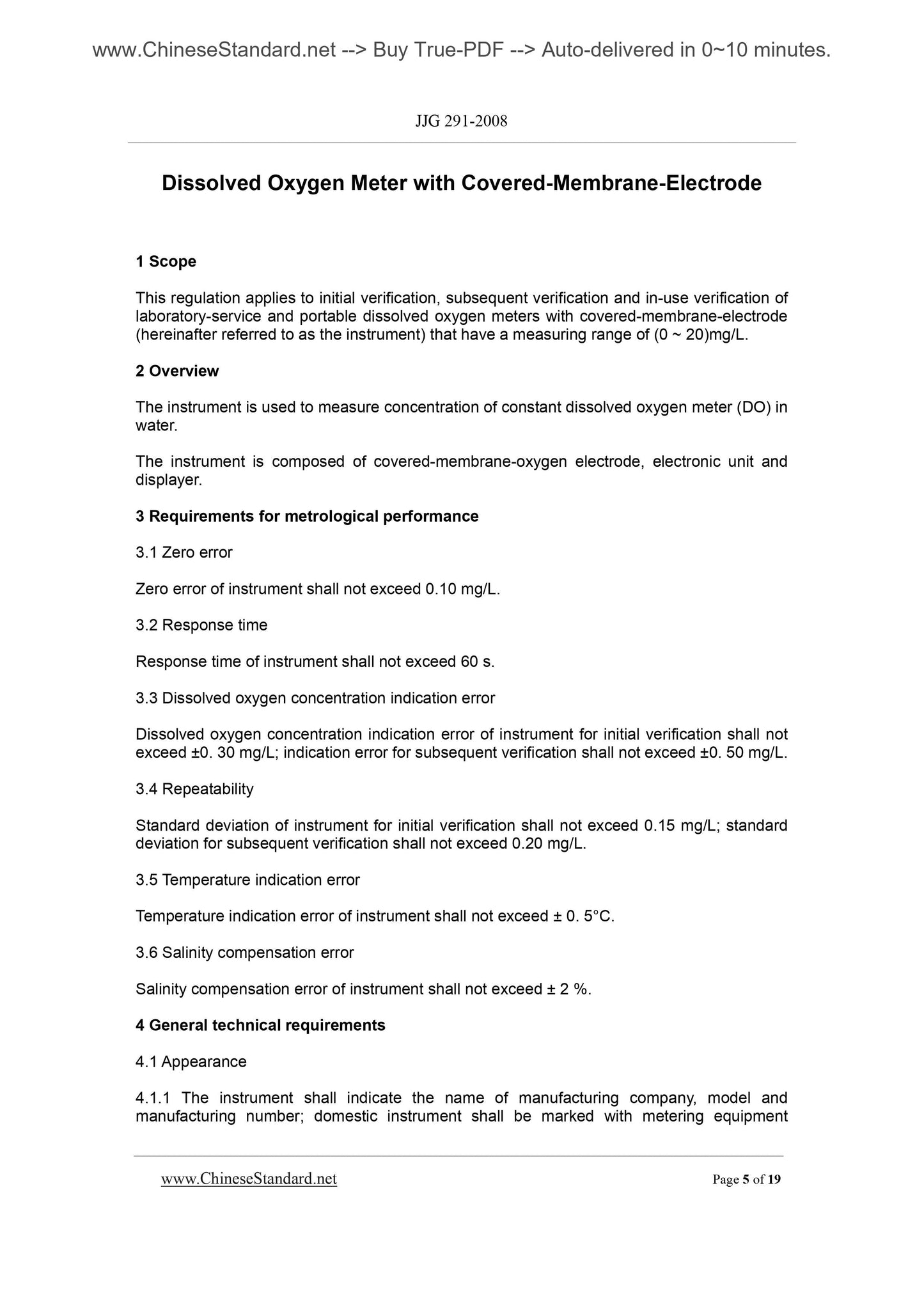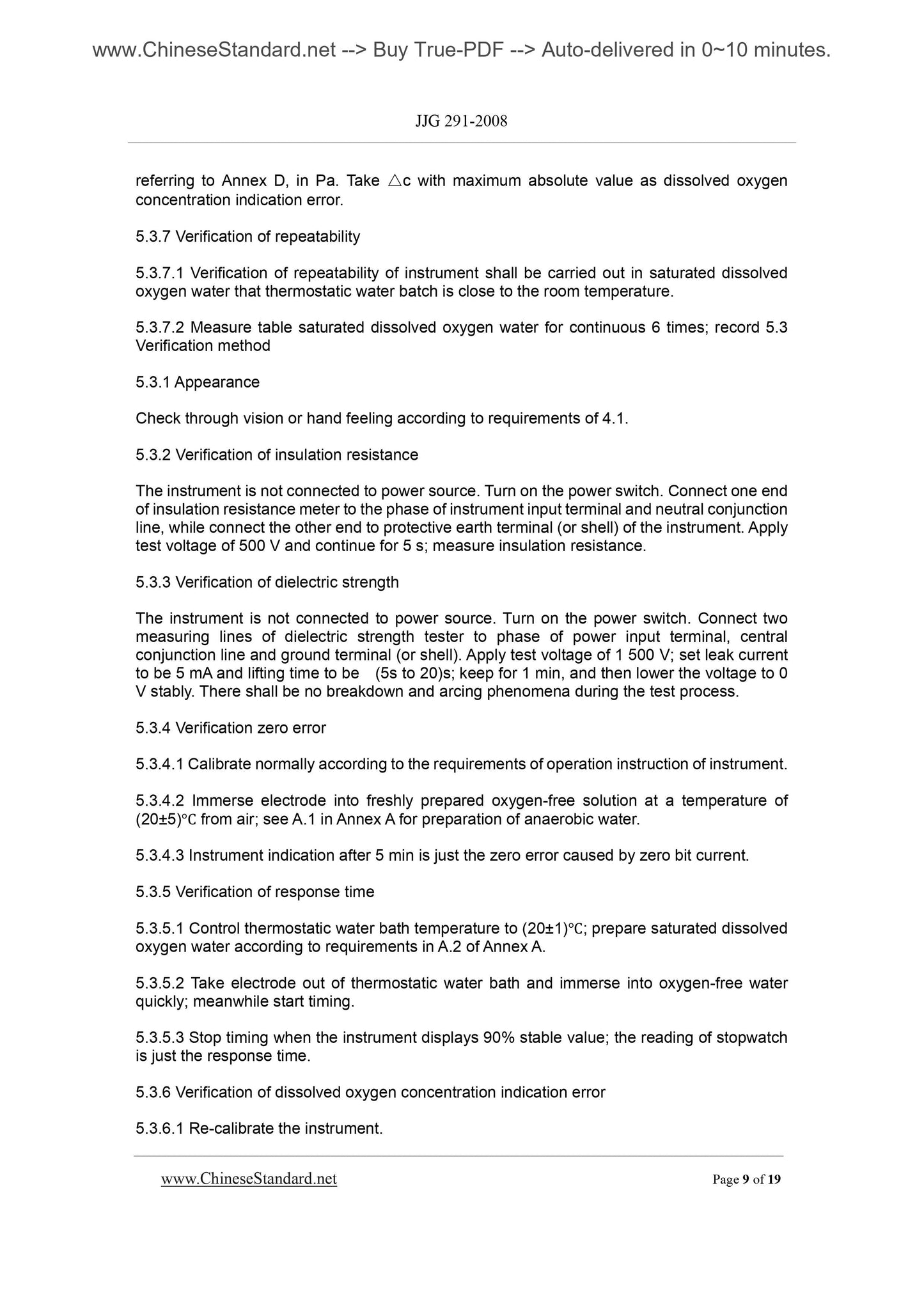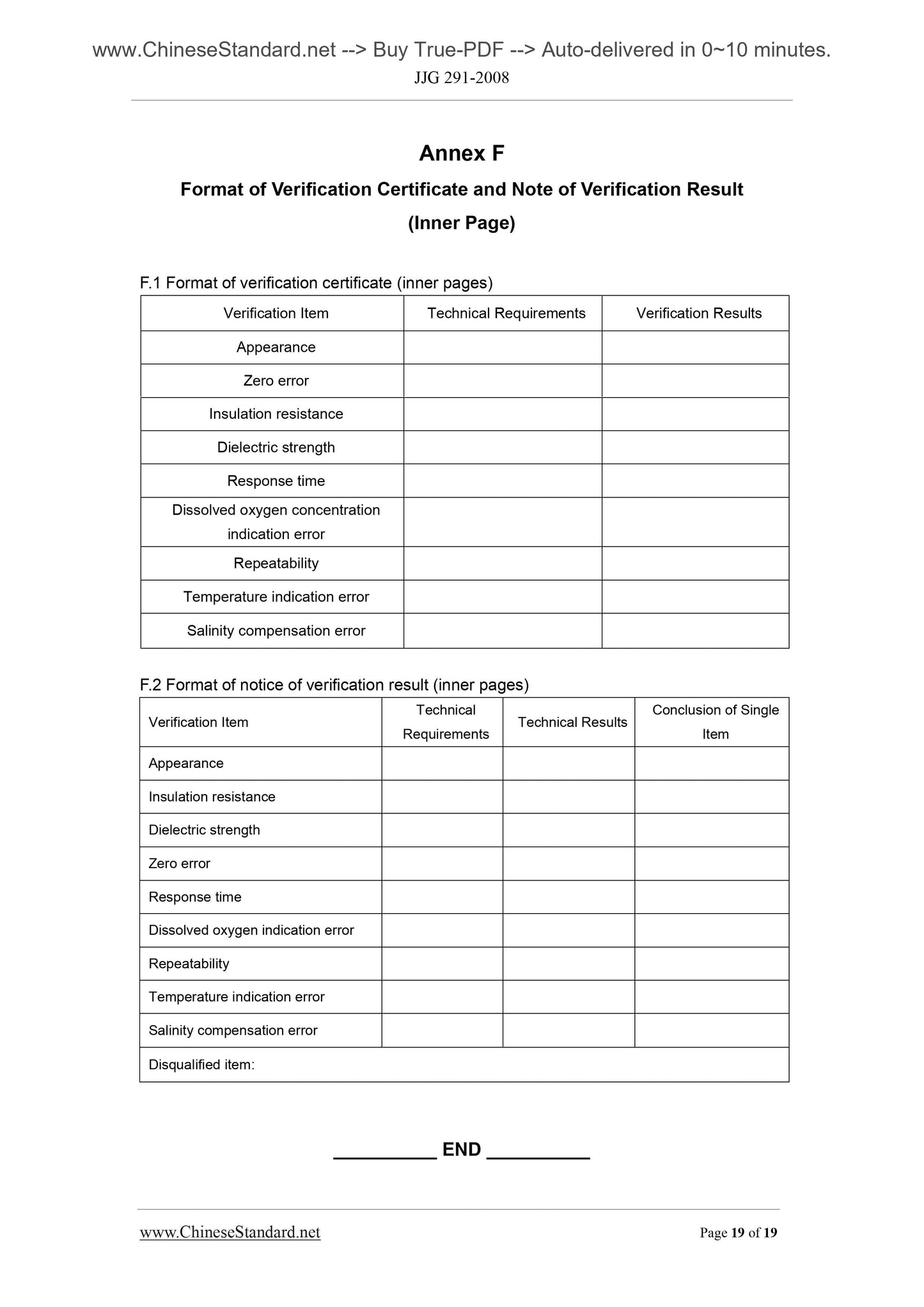1
/
of
8
PayPal, credit cards. Download editable-PDF and invoice in 1 second!
JJG 291-2008 English PDF (JJG291-2008)
JJG 291-2008 English PDF (JJG291-2008)
Regular price
$170.00 USD
Regular price
Sale price
$170.00 USD
Unit price
/
per
Shipping calculated at checkout.
Couldn't load pickup availability
Delivery: 3 seconds. Download true-PDF + Invoice.
Get QUOTATION in 1-minute: Click JJG 291-2008
Historical versions: JJG 291-2008
Preview True-PDF (Reload/Scroll if blank)
JJG 291-2008: Verification regulation of dissolved oxygen meter with covered-membrane-electrode
JJG 291-2008
JJF
National Metrology Technical Specifications
of the People's Republic of China
Dissolved Oxygen Meter with Covered-Membrane-
Electrode
ISSUED ON. DECEMBER 23, 2008
IMPLEMENTED ON. JUNE 23, 2009
Issued by. State Administration for Quality Supervision and Inspection and
Quarantine
Verification Regulation of Dissolved Oxygen
Meter with Covered-Membrane-Electrode
Replacing JJG 291-1999
This regulation was approved by General Administration of Quality Supervision, Inspection
and Quarantine on December 23, 2008 and shall be implemented from June 23, 2009.
Jurisdictional organization.
National Technical Committee on Environmental Stoichiometry
Drafting organization.
Zhejiang Province Institute of Metrology
This regulation is entrusted to and shall be responsibly interpreted by National Technical
Committee on Environmental Stoichiometry.
Drafter of this regulation.
Zhang Yanqun (Zhejiang Province Institute of Metrology)
Table of Contents
1 Scope ... 5
2 Overview ... 5
3 Requirements for metrological performance ... 5
4 General technical requirements ... 5
5 Measuring instrument control ... 6
Annex A Preparation of Water for Verification ... 13
Annex B Structural Drawing of Device for Verification Water Preparation ... 14
Annex C Saturation concentration table of oxygen in water with different temperatures
... 15
Annex D Saturated Vapor Pressure of Pure Water at Different Temperatures... 16
Annex E Verification Record ... 17
Annex F Format of Verification Certificate and Note of Verification Result ... 19
(Inner Page) ... 19
Dissolved Oxygen Meter with Covered-Membrane-Electrode
1 Scope
This regulation applies to initial verification, subsequent verification and in-use verification of
laboratory-service and portable dissolved oxygen meters with covered-membrane-electrode
(hereinafter referred to as the instrument) that have a measuring range of (0 ~ 20)mg/L.
2 Overview
The instrument is used to measure concentration of constant dissolved oxygen meter (DO) in
water.
The instrument is composed of covered-membrane-oxygen electrode, electronic unit and
displayer.
3 Requirements for metrological performance
3.1 Zero error
Zero error of instrument shall not exceed 0.10 mg/L.
3.2 Response time
Response time of instrument shall not exceed 60 s.
3.3 Dissolved oxygen concentration indication error
Dissolved oxygen concentration indication error of instrument for initial verification shall not
exceed ±0. 30 mg/L; indication error for subsequent verification shall not exceed ±0. 50 mg/L.
3.4 Repeatability
Standard deviation of instrument for initial verification shall not exceed 0.15 mg/L; standard
deviation for subsequent verification shall not exceed 0.20 mg/L.
3.5 Temperature indication error
Temperature indication error of instrument shall not exceed ± 0. 5°C.
3.6 Salinity compensation error
Salinity compensation error of instrument shall not exceed ± 2 %.
4 General technical requirements
4.1 Appearance
4.1.1 The instrument shall indicate the name of manufacturing company, model and
manufacturing number; domestic instrument shall be marked with metering equipment
referring to Annex D, in Pa. Take △c with maximum absolute value as dissolved oxygen
concentration indication error.
5.3.7 Verification of repeatability
5.3.7.1 Verification of repeatability of instrument shall be carried out in saturated dissolved
oxygen water that thermostatic water batch is close to the room temperature.
5.3.7.2 Measure table saturated dissolved oxygen water for continuous 6 times; record 5.3
Verification method
5.3.1 Appearance
Check through vision or hand feeling according to requirements of 4.1.
5.3.2 Verification of insulation resistance
The instrument is not connected to power source. Turn on the power switch. Connect one end
of insulation resistance meter to the phase of instrument input terminal and neutral conjunction
line, while connect the other end to protective earth terminal (or shell) of the instrument. Apply
test voltage of 500 V and continue for 5 s; measure insulation resistance.
5.3.3 Verification of dielectric strength
The instrument is not connected to power source. Turn on the power switch. Connect two
measuring lines of dielectric strength tester to phase of power input terminal, central
conjunction line and ground terminal (or shell). Apply test voltage of 1 500 V; set leak current
to be 5 mA and lifting time to be (5s to 20)s; keep for 1 min, and then lower the voltage to 0
V stably. There shall be no breakdown and arcing phenomena during the test process.
5.3.4 Verification zero error
5.3.4.1 Calibrate normally according to the requirements of operation instruction of instrument.
5.3.4.2 Immerse electrode into freshly prepared oxygen-free solution at a temperature of
(20±5)°C from air; see A.1 in Annex A for preparation of anaerobic water.
5.3.4.3 Instrument indication after 5 min is just the zero error caused by zero bit current.
5.3.5 Verification of response time
5.3.5.1 Control thermostatic water bath temperature to (20±1)°C; prepare saturated dissolved
oxygen water according to requirements in A.2 of Annex A.
5.3.5.2 Take electrode out of thermostatic water bath and immerse into oxygen-free water
quickly; meanwhile start timing.
5.3.5.3 Stop timing when the instrument displays 90% stable value; the reading of stopwatch
is just the response time.
5.3.6 Verification of dissolved oxygen concentration indication error
5.3.6.1 Re-calibrate the instrument.
instrument according to Formula (4).
)4...(...si
Where,
Ti - Instrument indication temperature value, in °C;
Ts - Reading of precision thermometer, in °C.
Take △T with maximum absolute value as instrument temperature indication error of
instrument.
5.3.9 Verification of salinity compensation error
5.3.9.1 Pour 1 L of distilled water into the beaker; place it into thermostatic water bath at a
temperature of (15±0.2)°C; stop bubbling 1 h after the start; still for 10 min and measure
concentration N0 of dissolved oxygen concentration with zero salt. Standard value of water
dissolved oxygen concentration that salt content is n(g/L) is obtained according to Formula (5).
)5...(...9055.0-0sn nNN
Where,
n - Salt (NaCl) in grams, n may be 10g, 20g and 30g.
Note. 0.055 9 refers to the variation of solubility when water temperature is 15°C and salt content is 1 g/L
(△Cs). See Annex A of GB/T 11913- 1989.
5.3.9.2 Maintain pure water temperature 15°C; add salt of 10 g and stir uniformly; prepare it to
be saturated dissolved oxygen water that salt content is 10 g/L and measure to get N10
(measure for 2 times and take the average value). Use the same method to prepare water into
saturated dissolved oxygen water that salt content is 20, 30 g/L and measure to get N20 and
N30 respectively. Calculate salinity compensation error according to Formula (6).
߂ܰ ൌ ܰିܰ௦ܰୱ ൈ 100% ... (6)
Where,
Nn - Concentration of saline dissolved oxygen, which may be N10, N20, N30, in mg/L.
Take the △N with the maximum absolute value as salinity compensation error of instrument.
5.4 Verification results handling
5.4.1 In case of poor electrode performance discovered during verification process, it is
allowed to replace electrode electrolyte and membrane; re-verification is required after the
replacement.
5.4.2 Issue verification qualification certificate for instruments tha...
Get QUOTATION in 1-minute: Click JJG 291-2008
Historical versions: JJG 291-2008
Preview True-PDF (Reload/Scroll if blank)
JJG 291-2008: Verification regulation of dissolved oxygen meter with covered-membrane-electrode
JJG 291-2008
JJF
National Metrology Technical Specifications
of the People's Republic of China
Dissolved Oxygen Meter with Covered-Membrane-
Electrode
ISSUED ON. DECEMBER 23, 2008
IMPLEMENTED ON. JUNE 23, 2009
Issued by. State Administration for Quality Supervision and Inspection and
Quarantine
Verification Regulation of Dissolved Oxygen
Meter with Covered-Membrane-Electrode
Replacing JJG 291-1999
This regulation was approved by General Administration of Quality Supervision, Inspection
and Quarantine on December 23, 2008 and shall be implemented from June 23, 2009.
Jurisdictional organization.
National Technical Committee on Environmental Stoichiometry
Drafting organization.
Zhejiang Province Institute of Metrology
This regulation is entrusted to and shall be responsibly interpreted by National Technical
Committee on Environmental Stoichiometry.
Drafter of this regulation.
Zhang Yanqun (Zhejiang Province Institute of Metrology)
Table of Contents
1 Scope ... 5
2 Overview ... 5
3 Requirements for metrological performance ... 5
4 General technical requirements ... 5
5 Measuring instrument control ... 6
Annex A Preparation of Water for Verification ... 13
Annex B Structural Drawing of Device for Verification Water Preparation ... 14
Annex C Saturation concentration table of oxygen in water with different temperatures
... 15
Annex D Saturated Vapor Pressure of Pure Water at Different Temperatures... 16
Annex E Verification Record ... 17
Annex F Format of Verification Certificate and Note of Verification Result ... 19
(Inner Page) ... 19
Dissolved Oxygen Meter with Covered-Membrane-Electrode
1 Scope
This regulation applies to initial verification, subsequent verification and in-use verification of
laboratory-service and portable dissolved oxygen meters with covered-membrane-electrode
(hereinafter referred to as the instrument) that have a measuring range of (0 ~ 20)mg/L.
2 Overview
The instrument is used to measure concentration of constant dissolved oxygen meter (DO) in
water.
The instrument is composed of covered-membrane-oxygen electrode, electronic unit and
displayer.
3 Requirements for metrological performance
3.1 Zero error
Zero error of instrument shall not exceed 0.10 mg/L.
3.2 Response time
Response time of instrument shall not exceed 60 s.
3.3 Dissolved oxygen concentration indication error
Dissolved oxygen concentration indication error of instrument for initial verification shall not
exceed ±0. 30 mg/L; indication error for subsequent verification shall not exceed ±0. 50 mg/L.
3.4 Repeatability
Standard deviation of instrument for initial verification shall not exceed 0.15 mg/L; standard
deviation for subsequent verification shall not exceed 0.20 mg/L.
3.5 Temperature indication error
Temperature indication error of instrument shall not exceed ± 0. 5°C.
3.6 Salinity compensation error
Salinity compensation error of instrument shall not exceed ± 2 %.
4 General technical requirements
4.1 Appearance
4.1.1 The instrument shall indicate the name of manufacturing company, model and
manufacturing number; domestic instrument shall be marked with metering equipment
referring to Annex D, in Pa. Take △c with maximum absolute value as dissolved oxygen
concentration indication error.
5.3.7 Verification of repeatability
5.3.7.1 Verification of repeatability of instrument shall be carried out in saturated dissolved
oxygen water that thermostatic water batch is close to the room temperature.
5.3.7.2 Measure table saturated dissolved oxygen water for continuous 6 times; record 5.3
Verification method
5.3.1 Appearance
Check through vision or hand feeling according to requirements of 4.1.
5.3.2 Verification of insulation resistance
The instrument is not connected to power source. Turn on the power switch. Connect one end
of insulation resistance meter to the phase of instrument input terminal and neutral conjunction
line, while connect the other end to protective earth terminal (or shell) of the instrument. Apply
test voltage of 500 V and continue for 5 s; measure insulation resistance.
5.3.3 Verification of dielectric strength
The instrument is not connected to power source. Turn on the power switch. Connect two
measuring lines of dielectric strength tester to phase of power input terminal, central
conjunction line and ground terminal (or shell). Apply test voltage of 1 500 V; set leak current
to be 5 mA and lifting time to be (5s to 20)s; keep for 1 min, and then lower the voltage to 0
V stably. There shall be no breakdown and arcing phenomena during the test process.
5.3.4 Verification zero error
5.3.4.1 Calibrate normally according to the requirements of operation instruction of instrument.
5.3.4.2 Immerse electrode into freshly prepared oxygen-free solution at a temperature of
(20±5)°C from air; see A.1 in Annex A for preparation of anaerobic water.
5.3.4.3 Instrument indication after 5 min is just the zero error caused by zero bit current.
5.3.5 Verification of response time
5.3.5.1 Control thermostatic water bath temperature to (20±1)°C; prepare saturated dissolved
oxygen water according to requirements in A.2 of Annex A.
5.3.5.2 Take electrode out of thermostatic water bath and immerse into oxygen-free water
quickly; meanwhile start timing.
5.3.5.3 Stop timing when the instrument displays 90% stable value; the reading of stopwatch
is just the response time.
5.3.6 Verification of dissolved oxygen concentration indication error
5.3.6.1 Re-calibrate the instrument.
instrument according to Formula (4).
)4...(...si
Where,
Ti - Instrument indication temperature value, in °C;
Ts - Reading of precision thermometer, in °C.
Take △T with maximum absolute value as instrument temperature indication error of
instrument.
5.3.9 Verification of salinity compensation error
5.3.9.1 Pour 1 L of distilled water into the beaker; place it into thermostatic water bath at a
temperature of (15±0.2)°C; stop bubbling 1 h after the start; still for 10 min and measure
concentration N0 of dissolved oxygen concentration with zero salt. Standard value of water
dissolved oxygen concentration that salt content is n(g/L) is obtained according to Formula (5).
)5...(...9055.0-0sn nNN
Where,
n - Salt (NaCl) in grams, n may be 10g, 20g and 30g.
Note. 0.055 9 refers to the variation of solubility when water temperature is 15°C and salt content is 1 g/L
(△Cs). See Annex A of GB/T 11913- 1989.
5.3.9.2 Maintain pure water temperature 15°C; add salt of 10 g and stir uniformly; prepare it to
be saturated dissolved oxygen water that salt content is 10 g/L and measure to get N10
(measure for 2 times and take the average value). Use the same method to prepare water into
saturated dissolved oxygen water that salt content is 20, 30 g/L and measure to get N20 and
N30 respectively. Calculate salinity compensation error according to Formula (6).
߂ܰ ൌ ܰିܰ௦ܰୱ ൈ 100% ... (6)
Where,
Nn - Concentration of saline dissolved oxygen, which may be N10, N20, N30, in mg/L.
Take the △N with the maximum absolute value as salinity compensation error of instrument.
5.4 Verification results handling
5.4.1 In case of poor electrode performance discovered during verification process, it is
allowed to replace electrode electrolyte and membrane; re-verification is required after the
replacement.
5.4.2 Issue verification qualification certificate for instruments tha...
Share
